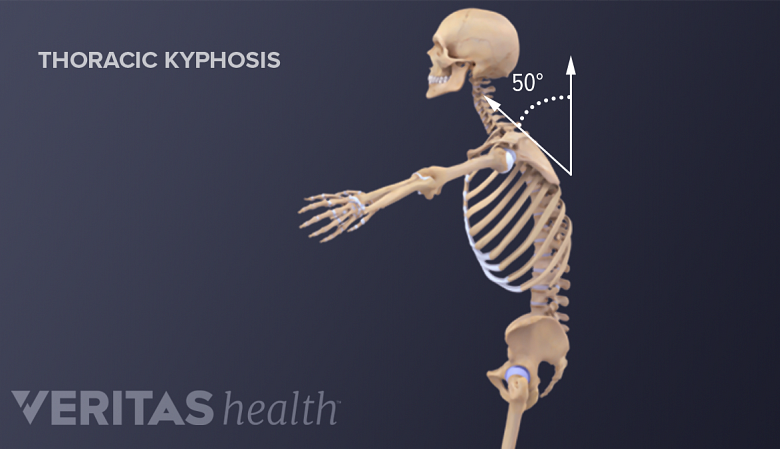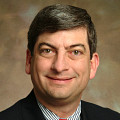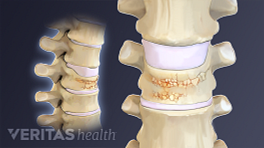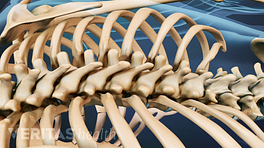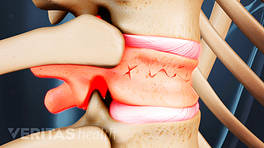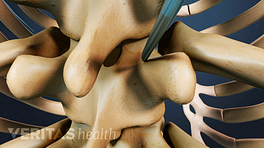The type of fracture in the spine that is typically caused by osteoporosis is generally referred to as a compression fracture.
A compression fracture is usually defined as a vertebral bone in the spine that has decreased at least 15 to 20% in height due to fracture.
These compression fractures can occur in vertebrae anywhere in the spine, but they tend to occur most commonly in the upper back (thoracic spine), particularly in the lower vertebrae of that section of the spine (e.g. T10, T11, T12). They rarely occur above the T7 level of the spine. They often occur in the upper lumbar segments as well, such as L1.
In This Article:
- When Back Pain Is a Spine Compression Fracture
- Vertebral Fracture Symptoms
- Osteoporosis: The Primary Cause of Collapsed Vertebrae
- Diagnosing Vertebral Compression Fractures
- Compression Fracture Treatment
Types of Fracture
Wedge fractures are the most common type of compression fracture in the spine.
A spinal fracture due to osteoporosis (weak bones) is commonly referred to as a compression fracture, but can also be called a vertebral fracture, osteoporotic fracture, or wedge fracture.
The term "wedge fracture" is used because the fracture usually occurs in the front of the vertebra, collapsing the bone in the front of the spine and leaving the back of the same bone unchanged. This process results in a wedge-shaped vertebra. A wedge compression fracture is generally a mechanically stable fracture pattern.
While wedge fractures are the most common type of compression fracture, there are other types as well, such as:
- Crush fracture. If the entire bone breaks, rather than just the front of the vertebra, it may be called a crush fracture.
- Burst fracture. This type of fracture involves some loss of the height in both the front and back walls of the vertebral body (rather than just the front of the vertebra). Making this distinction is important because burst fractures can be unstable and result in progressive deformity or neurologic compromise.
Compression Fracture Symptoms
Vertebral fractures may result in chronic pain and deformity, such as thoracic kyphosis.
Vertebral fractures are usually followed by acute back pain, and may lead to chronic pain, deformity (thoracic kyphosis, commonly referred to as a dowager's hump), loss of height, crowding of internal organs, and loss of muscle and aerobic conditioning due to lack of activity and exercise.
A combination of the above problems from vertebral fractures can also lead to changes in the individual's self-image, which in turn can adversely affect self-esteem and ability to carry on the activities of daily living.
Because the majority of damage is limited to the front of the vertebral column, the fracture is usually stable and rarely associated with any nerve or spinal cord damage.
Spinal Fractures are Common
Spinal compression fractures that occur as a result of osteoporosis are actually quite common, occurring in approximately 700,000 people in the U.S. each year. 1 "Advances in Osteoporosis Prevention, Diagnosis and Treatment Presented at 7th," National Osteoporosis Foundation, Accessed April 10, 2013. , 2 Riggs, B.L., Melton L.J. 3rd, "The worldwide problem of osteoporosis: insights afforded by epidemiology," Bone, 1995, 17(5 Suppl): p. 505S-511S.
See What You Need to Know About Osteoporosis
Osteoporosis is especially common in postmenopausal women. In fact, it is estimated that approximately 25% of all postmenopausal women in the United States have had a vertebral compression fracture. 3 Melton L.J. 3rd., "Epidemiology of spinal osteoporosis," Spine, 1997;22:2S-11S.
See Signs and Complications of Osteoporosis
While osteoporosis is far more prevalent in women - approximately four times as many women have low bone mass or osteoporosis as men - it still occurs in men. As many as 25% of men over age 50 will suffer a bone fracture (e.g. hip or spine) due to osteoporosis. 4 "Just for Men," National Osteoporosis Foundation, Accessed April 10, 2013.
The problem is that the fracture is not always recognized or accurately diagnosed - instead, the patient's pain is often just thought of as general back pain, such as from a muscle strain or other soft tissue injury, or as a common part of aging. As a result, approximately two thirds of the vertebral fractures that occur each year are not diagnosed and therefore not treated.
- 1 "Advances in Osteoporosis Prevention, Diagnosis and Treatment Presented at 7th," National Osteoporosis Foundation, Accessed April 10, 2013.
- 2 Riggs, B.L., Melton L.J. 3rd, "The worldwide problem of osteoporosis: insights afforded by epidemiology," Bone, 1995, 17(5 Suppl): p. 505S-511S.
- 3 Melton L.J. 3rd., "Epidemiology of spinal osteoporosis," Spine, 1997;22:2S-11S.
- 4 "Just for Men," National Osteoporosis Foundation, Accessed April 10, 2013.

